Jae-Wook Jung1, Joong-Bae Seo1, Jae-Sung Yoo1*
1Department of Orthopaedic Surgery, Dankook University College of Medicine, Cheonan, Korea
*Correspondence author: Jae-Sung Yoo, MD, Department of Orthopaedic Surgery, Dankook University College of Medicine, Manghyangro 201, Dongnam-gu, Cheonan, Chungnam 330-715, Republic of Korea;
Email: [email protected]
Published Date: 27-10-2024
Copyright© 2024 by Jung JW, et al. All rights reserved. This is an open access article distributed under the terms of the Creative Commons Attribution License, which permits unrestricted use, distribution, and reproduction in any medium, provided the original author and source are credited.
Abstract
In patient with lower limb disability, rotator cuff disorders are prevalent, with partial thickness tears occurring at nearly twice the rate of full thickness tears. For those with acromion spurs unresponsive to conservative treatment, rotator cuff repair via the take-down method poses a retear risk and requires extensive rehabilitation. Conversely, surgery utilizing bio-inductive collagen implants shows a lower retear risk and enables faster recovery, making it an appealing option for wheelchair athletes. Thus, the authors aim to present favorable outcomes from isolated bio-inductive collagen implant repair in a 45-year-old female wheelchair tennis player with a bursal side partial thickness tear, alongside a literature review.
Keywords: Shoulder; Rotator Cuff; Wheelchair; Tennis
Introduction
Patients with lower limb paralysis often rely on their upper limbs for mobility and daily activities, resulting in significant weight-bearing stress on their arm and shoulders [1]. To maintain the stability of the shoulder joint under weight-bearing stress, both the condition of static stabilizers like bony structures and ligaments, as well as dynamic stabilizers like the rotator cuff, are crucial. Consequently, the incidence of rotator cuff diseases is rising in patient with lower limb disability [2]. Studies indicate that the incidence of rotator cuff disorders in patients with lower limb disabilities is more than twice that of the general population [3]. However, due to the concern of not being able to use their upper limbs for weight-bearing during recovery and the higher re-tear rates compared to the general population, surgical treatment is performed at a very low rate in patients with lower limb paralysis [4]. Another report revealed that even with the difficult choice to pursue surgical treatment and a weight-bearing restriction for 3 months afterward, the re-tear rate remained significant at 25% [5].
Wheelchair tennis stands out as the most widely played adapted racket sport; however, it is associated with a significant frequency of shoulder issues [6]. In wheelchair tennis, holding the racket with one hand means that more force is applied to the opposite shoulder to turn the wheel and the seated position during strokes exerts significant stress on the shoulder mechanics.6 In wheelchair racket players, careful consideration is necessary during rotator cuff repair to facilitate a successful return to sports, as re-tears and collisions between the humerus and acromion may result in recurring shoulder pain.
Recent studies have reported positive clinical outcomes with the Bio-inductive collagen implant (REGENETEN; Smith & Nephew) [7,8]. Specifically, the Bio-inductive collagen implant has shown significant improvements in clinical symptoms for partial rotator cuff tears. Unlike traditional rotator cuff repairs, this implant offers a shorter immobilization period and faster recovery [8,9]. Furthermore, as there is no risk of re-tear, this approach offers benefits for athletes aiming for a swift return to their sport and for individuals with lower body paralysis who rely on their upper limbs for weight-bearing, since it reduces the chance of re-injury.
We think that using a bio-inductive collagen implant to treat paraplegic players with partial thickness rotator cuff injuries who exhibit persistent pain is an effective method for preventing re-tear and achieving rapid recovery. They aim to report a case study along with a review of the literature on this approach.
Case Report
A 45-year-old female wheelchair tennis player presented with persistent left shoulder pain for over a year. Her Visual Analog Scale (VAS) score was 8 and despite multiple injection treatments at another hospital, her pain had not improved. Both impingement signs I and II were positive and the empty can test was also positive. Shoulder Range of Motion (ROM) was normal without limitations, but she reported persistent pain affecting her performance. Magnetic Resonance Image (MRI) revealed a large subacromial spur and a partial thickness tear on the bursal side of the supraspinatus, with no damage observed in the subscapularis or posterior cuff (Fig. 1).
Technical Note
The surgery was carried out in the sitting position using a regional anesthesia. First, a diagnostic exam was performed using the posterior veiwing portal (Fig. 2). After confirming that there was no lesion in the glenohumeral joint, we approached the subacromial space. After sufficient bursectomy was performed to secure space, the large spur of the acromion was removed and acromioplasty was performed flat (Fig. 2).
Technical Note
The surgery was carried out in the sitting position using a regional anesthesia. First, a diagnostic exam was performed using the posterior veiwing portal (Fig. 2). After confirming that there was no lesion in the glenohumeral joint, we approached the subacromial space. After sufficient bursectomy was performed to secure space, the large spur of the acromion was removed and acromioplasty was performed flat (Fig. 2).
Three bone anchors were used to secure the lateral aspect of the bio-inductive collagen implant through the lateral portal. Care was taken to avoid excessive tension during fixation, as too much pulling could cause the implant to tear and placing the anchors too aggressively might result in the anchors penetrating through the implant without properly securing it. Appropriate force was used to ensure a firm fixation (Fig.3). Afterward, additional solid fixation was achieved by placing one or two tendon anchors in the central area where the delivery device had been removed (Fig. 3,4).
Post-operative Management and Outcomes
An ultra-sling was worn for 2 weeks post-surgery. Pendulum exercises commenced one day after the operation, followed by passive ROM exercises at one week, assisted active ROM at two weeks and active exercises starting at four weeks. Weight-bearing with crutches was restricted for 4 weeks post-surgery and the use of an electric wheelchair was recommended during this period.
Training and practice for tennis were allowed starting 6 weeks post-surgery, while return to actual matches was permitted at 12 weeks after an MRI confirmed the condition of the fixed bio-inductive collagen implant (Fig. 5). At six months post-surgery, MRI showed no signs of graft failure and confirmed healing of the partial thickness tear of supraspinatus (Fig. 6). The VAS score was 0, indicating a significant reduction in shoulder discomfort during games. The American Shoulder and Elbow Score and the Constant shoulder score both reached 100, reflecting excellent outcomes.
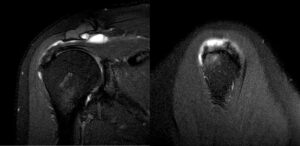
Figure 1: Bursal side partial thickness supraspinatus tear with subacromial spur was observed on the preoperative magnetic resonance imaging.
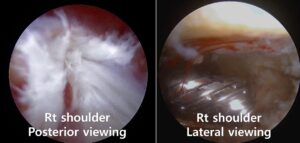
Figure 2: (A) Bursal side partial thickness supraspinatus tear was observed (B) The large spur of the acromion was removed and acromioplasty was performed flat.
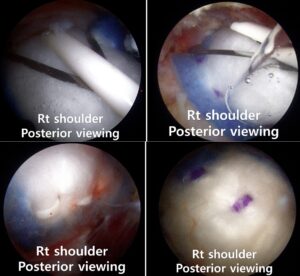
Figure 3: (A) The bioinductive collagen implant is positioned to cover the musculotendinous junction medially and the greater tuberosity laterally. (B) The implant is secured medially and in the midsection using 5-6 tendon anchors . (C) Three bone anchors were used to secure the lateral aspect of the collagen implant through the lateral portal. (D) Additional solid fixation was achieved by placing one or two tendon anchors in the central area where the delivery device had been removed.
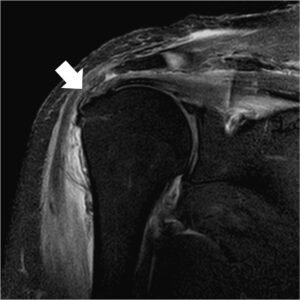
Figure 4: A bio-inductive collagen implant located on the tendon is observed in a post-operative magnetic resonance image.

Figure 5: In a magnetic resonance image 3 months after surgery, the bursal side partial tear was observed to have recovered, but the bio-inductive collagen implant was observed to have not yet been absorbed.
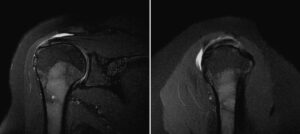
Figure 6: A magnetic resonance image 6 months after surgery showed that the bio-inductive collagen implant was absorbed and the bursal side partial tear was fully recovered.
Discussion
Rotator cuff disorders have a high incidence in patients with lower limb paralysis, but the lengthy rehabilitation period and elevated re-tear rates make treatment particularly challenging. Recent studies report pain and functional improvement after rotator cuff repair in patients with lower limb paralysis; however, long-term follow-up shows higher re-tear and recurrence rates compared to the general population [5,10]. To avoid re-tears, an extended period of immobilization and subsequent rehabilitation is necessary, which can significantly impact athletic performance, increasing the treatment burden for athletes. Furthermore, studies highlighting the potential for long-term pain recurrence after surgery make the choice of surgical treatment even more challenging.
In paraplegic patients, the majority of rotator cuff tears affect the supraspinatus. Mall, et al., ported that in patients with lower limb paralysis, rotator cuff tears predominantly occur in the supraspinatus or subscapularis, while tears in the infraspinatus are rare [11]. These patterns of rotator cuff damage are closely related to the lifestyle of patients with lower limb paralysis. Since they rely on their upper limbs for weight-bearing during transfers, using crutches or operating wheelchairs, vertical forces are transmitted to the shoulders, making injuries to the upper rotator cuff more common. Akbar, et al., also reported that the rate of supraspinatus tears in patients with lower limb paralysis is over 60%, showing a statistically significant higher incidence compared to the general population control group [3]. Therefore, in patients with lower limb paralysis, it is essential to consider vertical stress from weight-bearing to prevent recurrence even after rotator cuff surgery.
Recently, several studies have examined the use of bio-induced collagen implants for treating rotator cuff tears. Bushnell, et al., reported in 2021 that these implants led to a statistically significant reduction in re-tears and improved clinical outcomes after surgery. Moreover, their multicenter case series compared the bio-induced collagen implant technique to the take-down and repair method for partial thickness rotator cuff tears, demonstrating superior initial clinical results within six weeks [8,12,13].
Bushnell, et al., described the bio-induced collagen implant technique as a highly useful alternative for treating shoulder pain due to partial thickness tear of rotator cuff that do not resolve with conservative treatment [8]. Therefore, we believe that the bio-induced collagen implant technique, which has a shorter immobilization period and poses a lower risk of re-tear compared to traditional take down and repair methods, enables a quicker return to daily activities and faster clinical recovery. This makes it a particularly valuable treatment option for athletes who need to return to competition quickly.
Additionally, paraplegic patients must bear weight on the shoulder joint, which necessitates a longer immobilization period with the take-down and repair method due to the risk of re-tear. In contrast, the bio-induced collagen implant technique offers greater freedom from this risk. Moreover, it provides coverage for the sensory nerves located on the rotator cuff bursal side, potentially reducing shoulder pain that can occur during axial load due to irrigation with the acromion, making it a more advantageous option.
Conclusion
To establish the statistical significance of the bio-induced collagen implant technique outcomes in paraplegic tennis players, further evaluation with larger sample sizes are necessary. We aim to present a case study of a 45-year-old female paraplegic tennis player who, after undergoing the bio-induced collagen implant procedure, experienced improvements in pain and clinical outcomes without any graft failure, accompanied by a literature review.
Conflict of Interests
The authors declares that they have no conflict of interest in this paper.
Ethics Approval and Consent to Participate
This article does not contain any studies with human participants or animals performed by any of the authors. This study was reviewed and accepted by the Dankook University medical center Institutional Review Board.
Consent for Publication
All authors agree to publication
Availability of Data and Material
It is available when reviewers request.
Funding
There is no funding source.
Authors’ Contributions
J.B.S and J.S. Y. designed this study, J.S.Y and J.W.J. took the radiologic measurements and gathered the retrospective data.
References
- Hastings J, Goldstein B. Paraplegia and the shoulder. Phys Med Rehabil Clin N Am. 2004;15(3):vii, 699-718.
- Curtis KA, Drysdale GA, Lanza RD, Kolber M, Vitolo RS, West R. Shoulder pain in wheelchair users with tetraplegia and paraplegia. Arch Phys Med Rehabil. 1999;80(4):453-7.
- Akbar M, Balean G, Brunner M. Prevalence of rotator cuff tear in paraplegic patients compared with controls. J Bone Joint Surg Am. 2010;92(1):23-30.
- Pentland WE, Twomey LT. Upper limb function in persons with long term paraplegia and implications for independence: Part I. Paraplegia. 1994;32(4):211-8.
- Oh JH, Kim W, Kim JY, Rhee YG. Outcomes of rotator cuff repair in patients with comorbid disability in the extremities. Clin Orthop Surg. 2017;9(1):77-82.
- Reid M, Elliott B, Alderson J. Shoulder joint kinetics of the elite wheelchair tennis serve. Br J Sports Med. 2007;41(11):739-44.
- Dai A, Campbell A, Bloom D, Baron S, Begly J, Meislin R. Collagen-based bioinductive implant for treatment of partial thickness rotator cuff tears. Bull Hosp Jt Dis. 2020;78(3):195-201.
- Bushnell BD, Bishai SK, Krupp RJ. Treatment of partial-thickness rotator cuff tears with a resorbable bioinductive bovine collagen implant: 1-year results from a prospective multicenter registry. Orthop J Sports Med. 2021;9(8):23259671211027850.
- Thangarajah T, Ling FK, Lo IK. Isolated bioinductive arthroscopic repair of partial-thickness rotator cuff tears using a resorbable collagen implant. JBJS Essent Surg Tech. 2022;12(1).
- Valiquette AM, Graf AR, Mickschl DJ, Zganjar AJ, Grindel SI. Rotator cuff repair in upper extremity ambulators: an assessment of longitudinal outcomes. JSES Int. 2022;6(6):942-7.
- Mall NA, Lee AS, Chahal J. An evidenced-based examination of the epidemiology and outcomes of traumatic rotator cuff tears. Arthroscopy. 2013;29(2):366-76.
- Bushnell BD, Connor PM, Harris HW, Ho CP, Trenhaile SW, Abrams JS. Retear rates and clinical outcomes at 1 year after repair of full-thickness rotator cuff tears augmented with a bioinductive collagen implant: a prospective multicenter study. JSES Int. 2021;5(2):228-37.
- Schlegel TF, Abrams JS, Angelo RL, Getelman MH, Ho CP, Bushnell BD. Isolated bioinductive repair of partial-thickness rotator cuff tears using a resorbable bovine collagen implant: two-year radiologic and clinical outcomes from a prospective multicenter study. J Shoulder Elbow Surg. 2021;30(8):1938-48.
Article Type
Case Report
Publication History
Accepted Date: 29-09-2024
Accepted Date: 20-10-2024
Published Date: 27-10-2024
Copyright© 2024 by Jung JW, et al. All rights reserved. This is an open access article distributed under the terms of the Creative Commons Attribution License, which permits unrestricted use, distribution, and reproduction in any medium, provided the original author and source are credited.
Citation: Jung JW, et al. Treatment of Partial-Thickness Rotator Cuff Tears with Bio-Inductive Collagen Implant for Paraplegic Tennis Player: A Case Report. J Ortho Sci Res. 2024;5(3):1-8.

Figure 1: Bursal side partial thickness supraspinatus tear with subacromial spur was observed on the preoperative magnetic resonance imaging.

Figure 2: (A) Bursal side partial thickness supraspinatus tear was observed (B) The large spur of the acromion was removed and acromioplasty was performed flat.

Figure 3: (A) The bioinductive collagen implant is positioned to cover the musculotendinous junction medially and the greater tuberosity laterally. (B) The implant is secured medially and in the midsection using 5-6 tendon anchors . (C) Three bone anchors were used to secure the lateral aspect of the collagen implant through the lateral portal. (D) Additional solid fixation was achieved by placing one or two tendon anchors in the central area where the delivery device had been removed.

Figure 4: A bio-inductive collagen implant located on the tendon is observed in a post-operative magnetic resonance image.

Figure 5: In a magnetic resonance image 3 months after surgery, the bursal side partial tear was observed to have recovered, but the bio-inductive collagen implant was observed to have not yet been absorbed.

Figure 6: A magnetic resonance image 6 months after surgery showed that the bio-inductive collagen implant was absorbed and the bursal side partial tear was fully recovered.


